Australia 2008 "Australian Megafauna"
| <prev | back to index | next> |
| Issue Date | 01.10.2008 |
| ID |
Mint /
Self-adhesive Michel: 3102-3107, Bl. 79 / 3108-3111 ; Scott: 2975-2980, 2980c / 2981-2984 ; Stanley Gibbons: 3080-3085, MS3086 / 3087-3090 ; Yvert: 2980-2985, BF109 / 2985A-D ; Category: pR |
| Designer |
Stamp and cover illustration: Peter Trusler. Scientific consultant: Professor Patricia Vickers-Rich, Chair of Paleontology, Monash University. Stamp and cover design: Adam Crapp, Australia Post Design Studio. |
| Stamps in set | 6 |
| Value |
55c - Genyornis newtoni (Thunder bird) 55c - Diprotodon optatum (Giant Wombat) 55c - Thylacoleo carnifex (Marsupial Lion) 55c - Thylacinus cynocephalus (Tasmanian Tiger) $1.10 - Procoptodon goliah (Short-faced Giant Kangaroo) $1.10 - Megalania prisca (Giant Varanid) |
| Emission/Type | commemorative |
| Issue place | Monash University, Victoria 3800 |
| Size (width x height) |
stamps: 55c - 26mm x 37.5mm, $1.10 - 52mm x 37.5mm Mini-Sheet: 160mm x 90mm |
| Layout | Mint stamps:
55c - sheet of 50,
$1.10 -sheet of 20. Gutter-pairs stripes x2. Self-adhesive stamps: booklet of 10, box of 100. |
| Products | FDC x2, Mini-Sheet x1, Gutter Pairs strip of 55c stamps x1, Presentation Pack x1, Maxi Card set of 6, Medallion cover x1, Booklet with panels of 10 55c self-adhesive stamps (5x2) x1, Box of 100 self-adhesive stamps x1 (produced by two companies), |
| Paper | Tullis Russell, Phosphorized |
| Perforation | mint: 14.6 x 13.86, self-adhesive: die-cut 11.50x11.25 |
| Print Technique | Lithography |
| Printed by | "Energi Print P/L" (mint and self-adhesive) and "Pemara" (self-adhesive). |
| Quantity | ? |
| Issuing Authority | Australia Post |
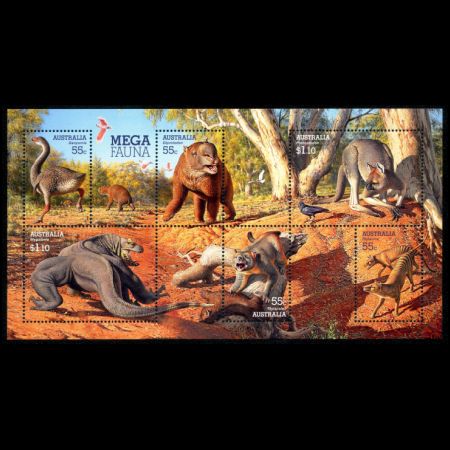
On October 1st, 2008, Australian Post issued the set of 6 stamps "Megafauna". These stamps show 6 prehistoric mammals from Australian continent and were issued in several formats:
- Two Sheets:
all four 55c stamps were printed together -
5 stamps in the row,
where the Genyornis stamp was printed twice at the beginning and the end of each row.
Both stamps with the face value of $1.10 were printed together - 5 stamps in the row - 3 stamps of Megalania + 2 stamps of Procoptodon. -
Some Sheets were printed with Gutter-pair rows.
The skeletons of the animals shown on the tabs between stamps of 55c.
The Sheet with tabs between stamps of $1.10 shows the "traffic light". This Sheet contains only 4 stamps in a row. - Mini-Sheet of all 6 stamps
- All four stamps with the face value of 55c were issued as self-adhesive in a booklet of 10 of and boxes with roles of 100 stamps. The boxes were produced by two different companies: "Energi Print P/L" and "Pemara". The coils from these boxes can be differentiated by distance of between stamps and the company name on the reverse side.
This issue focused on Australians megafauna - an extraordinary range of giant creatures that roamed the Australian continent many thousands and even millions of years ago and became extinct between 20,000 and 50,000 years ago (with the exception of the Tasmanian Tiger).
Noted Australian artist Peter Trusler has a long and close working relationship with Professor Patricia Vickers-Rich, the consulting palaeontologist on this stamp issue.
In 1993 a similar collaboration occurred when Peter illustrated the stamp issue "Australian Dinosaur Era" and again in 2005 with "Creatures of the Slime", the first living creatures.
Since the 1980's, Peter Trusler, trained as a biologist/anatomist (B.Sc. from Monash)
and wildlife artist has worked with Prof. Vickers-Rich and Dr. Thomas Rich on a number of projects
to visualize past environments.
Together they have produced many books (Wildlife of Gondwana (Indiana University Pres),
The Fossil Book (Doubleday), The Dinosaurs of Darkness (Allen & Unwin) and the cover of
Time Magazine in 1993.
Trusler has worked for National Geographic and two of his paintings of Australia's ancient past
grace the walls of the NGS Headquarters in Washington, DC.
In the introduction of the Prestige Booklet Professor Patricia Vickers-Rich wrote:
"
In order to illustrate the megafauna as accurately as possible, artist Peter Trusler undertakes
extensive research before he begins his work.
As the source material is often fragmentary, Peter first reads as much as he can on the selected species
of what fossilised remains and skeletons may exist; of where and how they were found and of the
various hypotheses that exist on how they may have looked like, their size, particular characteristics,
and behaviour.
He will then search through museum collections and take relevant sketch notes and photos before
investigating the actual sites where many of the skeletons and fossils were found.
And lastly Peter discussed anatomical issues with a number of experts from museums and academic institutions.
The detailed illustrative process then begins, a process that involves three stages -
skeleton reconstruction; muscle reconstruction; and finally the whole animal reconstruction stage.
Great thought and attention goes into every aspect of Peter's work including the posture arid scale of the
animals and their likely environment.
Refinements continue to be made until Peter is happy that his Illustrations accommodate the basic structure
of the animals revealed by the fossil data and all the elements in the wider scene are reconciled with
current scientific thinking.
But Peter is not simply recreating scientifically accurate extinct animals he is also an artist and as
such creates panoramas of exquisite detail, drama and harmony with strong intrinsic visual rhythms.
"
The setting of the Mini-Sheet is an outback creek, which previous to the last glaciation would have been lusher than the arid environment of today. In the unfolding story, a Thylacoleo (Australian's marsupial lion) has scavenged or killed a young Diprotopon (giant wombat). Two other predatory species, the Megalania (giant varanid) and Thylacine, close in on the Thylaceleo. The mother Diprotodon attempts to repel the predators, while the Genyornis (the last of the large flightless birds) and other species, flee the scene. The Procoptdon (giant short-faced kangaroo) looks on from the far creek bank. The setting also includes Major Mitchell Cockatoos and modern Macropos Kangaroos, both species existing in the late Pleistocene period.
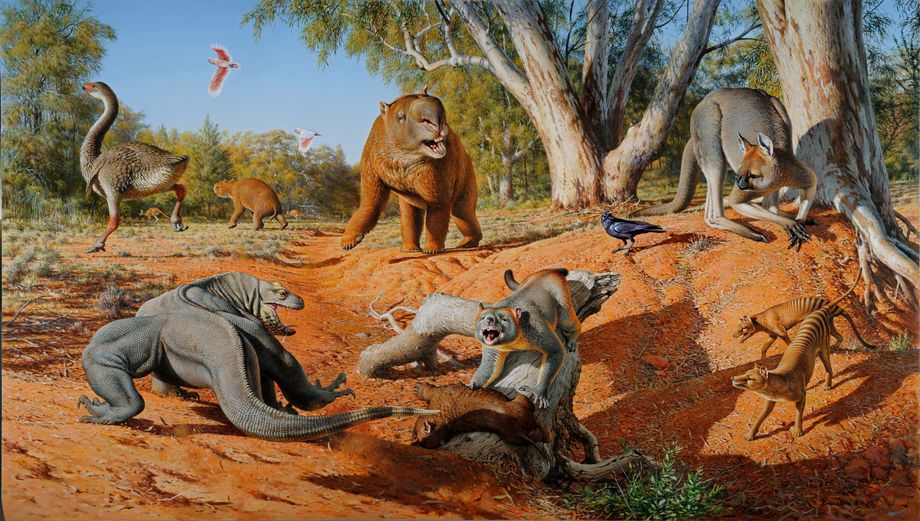
Image credit: Geomar
Genyornis
Although resembling the emu and the cassowary, the Genyornis is not related to them - instead, it appears related to ducks, geese and swans and the living South American screamers of the Anhimidae family. The carbon isotopes in the bones of Genyornis suggest that it ate perennials, shrubs and herbaceous plants.
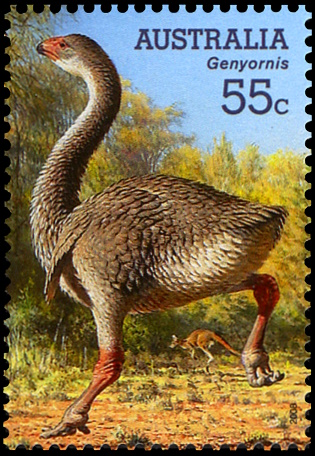 |
| Genyornis on stamp of Australia 2008, MiNr.: 3102, Scott: 2975. |
The first bones were reported by Sir Richard Owen, a British anatomist who described many of this continent's fossil animals, from the Wellington Caves in the 1830s, but the most complete remains found thus far have come from the Lake Callabonna salt pan in northern South Australia, where an expedition from the South Australian Museum recovered complete skeletons in the late 1890s.
Diprotodon
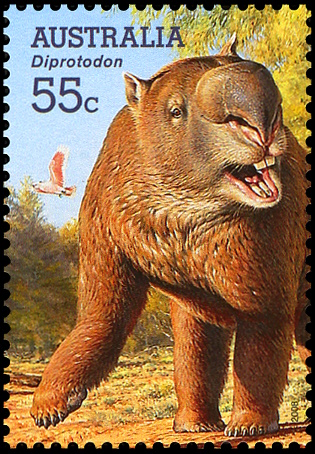 |
| Diprotodon on stamp of Australia 2008, MiNr.: 3103, Scott: 2976. |
Diprotodon was the first fossil mammal from Australia to be given a scientific name - in 1838 by Sir Richard Owen. The name means "two forward teeth", referring to the two prominently projecting incisors in the lower jaw that point straight ahead. A reward was posted, by Owen, for the finding of a complete foot of this enigmatic pouched beast and it was not until 1892, after Owen died, at Lake Callabonna, that articulated skeletons, including complete feet and even trackways, were excavated.
Diprotodon was Australian's largest marsupial, a quadruped with complex feet that almost seemed too small to support its weight. One big toe opposed all others in a fashion that reflected its arboreal ancestry. Diprotodon seemed to thrive on the grasslands and may have lived in small herds, but as aridity increased and water decreased, they could not cope.
Extended droughts would have made much of inland Australia uninhabitable; hundreds of individuals have been found at the centre of Lake Callabonna in northern South Australia, trapped in the mud as the lakebed dried out. On the Darling Downs in Queensland, one study of Diprotodon habitat has found that areas once covered in woodlands, vine thickets and scrublands gave way to grasslands as the climate became drier.
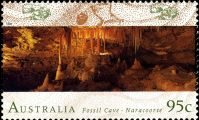
|
| Fossil cave - Naracoorte. One of the many sites in Australia where fossils of Diprotodon were found. Diprotodon skull and skeleton of Procoptodon goliah are featured on the top side of the stamp. Australia 1996, "Australian World Heritage Sites", MiNr. 1538, SCott: 1487. |
There is some evidence of either predation or scavenging of Diprotodon by the Pleistocene 'marsupial lion', Thylacoleo carnifex: a forelimb bone (ulna) from near Glen Innes, New South Wales was found with deep, blade-like tooth marks matching those of Thylacoleo (whose teeth were also found at the site).
Thylacoleo
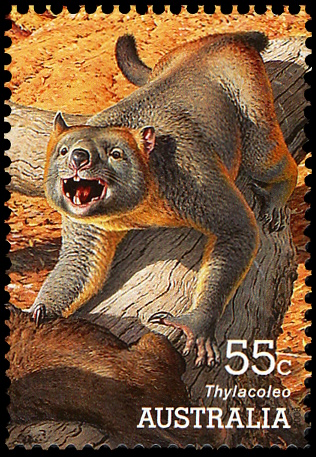 |
| Thylacoleo on stamp of Australia 2008, MiNr.: 3104, Scott: 2977. |
Few extinct animals from Australia have aroused so much curiosity. Some reconstruct this strange marsupial as an efficient carnivore, others as an omnivore and still others, such as American palaeontologist E. Drinker Cope in 1884 as a fruit or egg eater!
Thylacoleo harked from a possum ancestry and it retains the anatomy in its hands and feet typical of animals adapted to life in the trees — but adaptations in the forelimb that could also have been useful in manipulating prey.
Its hand is made up of four relatively slender, elongated digits with small claws and a manoeuvrable thumb with a large, hooded claw. Another most unusual feature of Thylacoleo is its skull with cheek teeth dominated by a huge, blade-like third premolar. This has been compared to the shearing carnassial teeth in placental carnivores, such as cats and dogs.
Thylacoleo, with the dimensions of a modern lioness, up to 160 kilograms in weight, and with premolar guillotines so powerful that they doubled as bolt cutters, for crushing bone as well as slicing flesh make these "marsupial lions" not only the largest mammalian predators in Australia of their time, but also one of the most efficient predators in mammal history. Not only did they have a very strong bite, but they were also able to climb trees using their flexible forelimbs and shoulders reducing the possibility that their prey could escape.
Thylacine
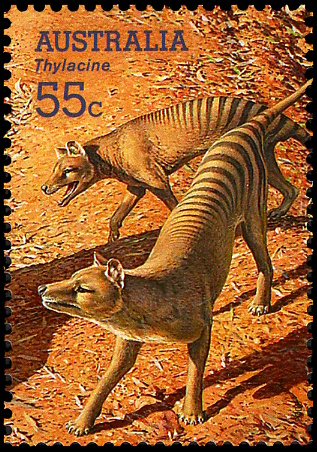 |
| Thylacine on stamp of Australia 2008, MiNr.: 3105, Scott: 2978. |
The Thylacine has a long history in Australia, dating back to at least the Miocene. Europeans first knew it as a living marsupial restricted to Tasmania, yet Thylacines had survived on mainland Australia until at least 3,300 years ago. The introduction of the dingo by humans pushed Thylacine to extinction on the mainland. Actively hunted in Tasmania in the 1800s as sheep farming spread, the final living individual died in the Hobart Zoo in 1933. Although neither a wolf nor tiger, it was given its misleading name because it was dog-like and possessed stripes.
In 2009 an international team of geneticists announced that they had successfully sequenced the genome of the thylacine. In 2022 Colossal Inc., an American biotechnology company, and the University of Melbourne’s Thylacine Integrated Genomic Restoration Lab announced a partnership to resurrect the species and reintroduce it to Tasmania.
Procoptodon goliah
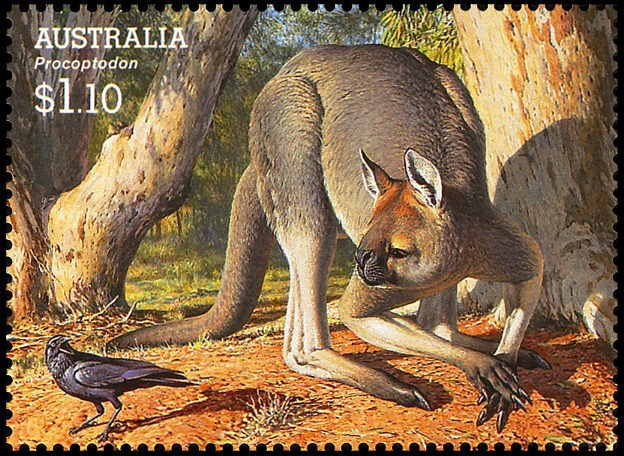 |
| Procoptodon on stamp of Australia 2008, MiNr.: 3107, Scott: 2980. |
According to the Australian Museum, Procoptodon would have co-existed with Aboriginal people for as long as 30,000 years. In NSW Aboriginal people continue to have stories about a long-armed aggressive kangaroo that fits the description of the species. These animals may have survived in some parts of Australia until around 18,000 years ago.
Megalania
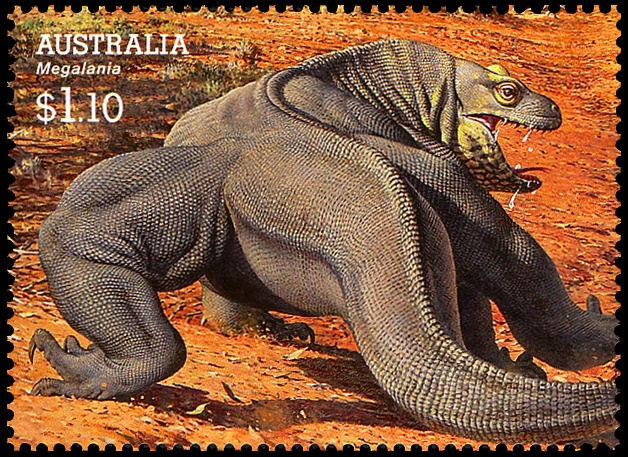 |
| Megalania on stamp of Australia 2008, MiNr.: 3106, Scott: 2979. |
Megalania is not known from complete skeletons and so some of its reconstruction is based on the living varanid lizards. But, there are certainly differences. Its teeth are more widely spaced than in other varanids. They are also more curved, sharply smooth in front, but serrated at the rear, giving Megalania a very formidable bite in contrast to unserrated teeth in other species. Unlike any known varanid, Megalania had a short crest on the top of its skull. In Asia the first fossil records of varanids occur at a time when Australia was separating from Antarctica, but they do not occur in our record until the time Australia began its collision with Southeast Asia.
Note: The biggest part of the text above was written by Professor Patricia Vickers-Rich, Chair of Paleontology, Monash University, who was scientific consultant for these stamps issue. She wrote the text for the "Prestige Booklet" and Stamp Bulletin of Australian Post in 2008.
Products and associated philatelic items
| Official FDCs | Medallion Cover | |
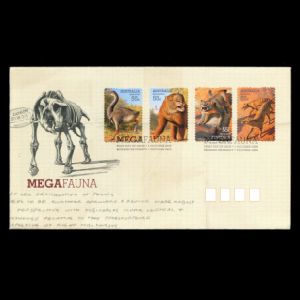 |
 |
 |
| The reverse side is here | The reverse side is here | |
| Mini-Sheets (clean and surcharged) | ||
| Original | Surcharged at Beijing stamp shows in 2008 | Surcharged in 2022 for "Impression Collection: Animals of the Deep Past" |
 |
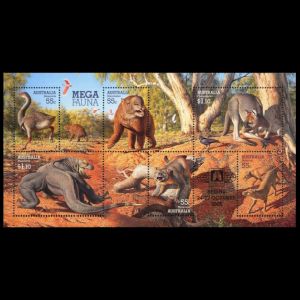 |
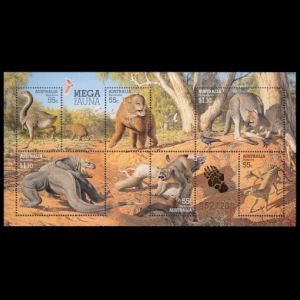 |
| The Mini-Sheet, as well as single stamps, sold by Australian Post in small plastic bags with a piece of thick paper. | Surcharged postmarks used black ink. * Surcharged Mini-sheets from other stamp shows may exist. |
Surcharged postmarks on the numbered Mini-Sheet used golden ink. The postmark depicts the footprint of Diprotodon |
| Gutter Pairs | Presentation Pack | |
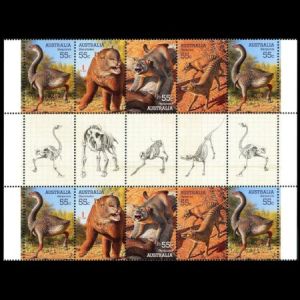 |
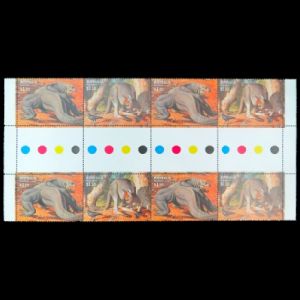 |
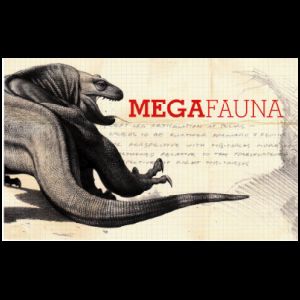 |
| Stamps from the Sheets | Prestige Booklet | |
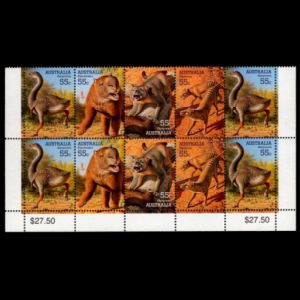 |
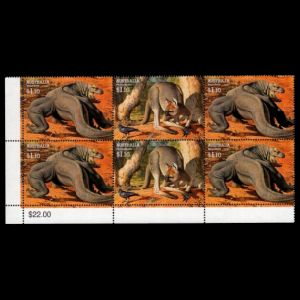 |
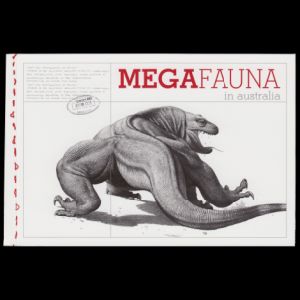 |
| Special Postmarks: "Stampex 2008" | Mini-Sheets from the Prestige Booklet | |
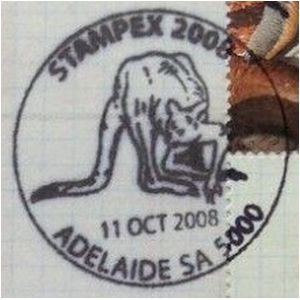 |
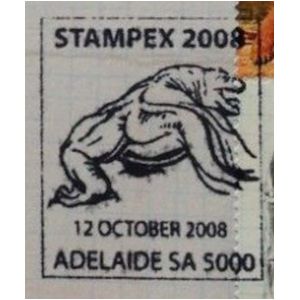 |
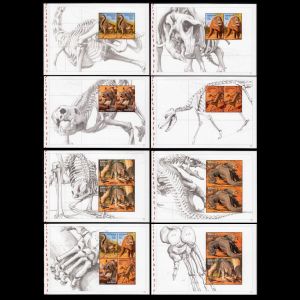 |
| Example of Circulated Covers and Postcards | Maxi Cards | |
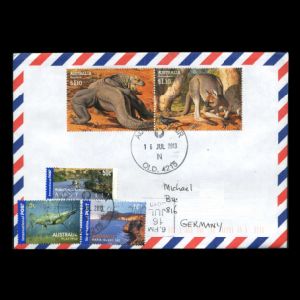 |
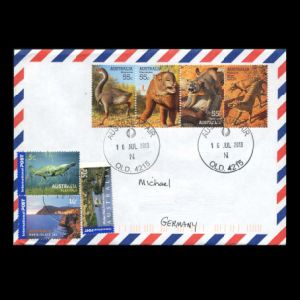 |
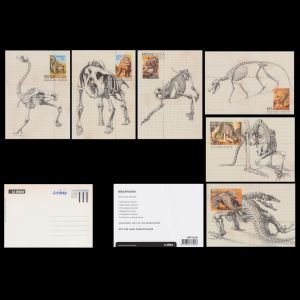 |
| Self-adhesive stamps | ||
| Booklet pane | Box stamps | Collector Pack |
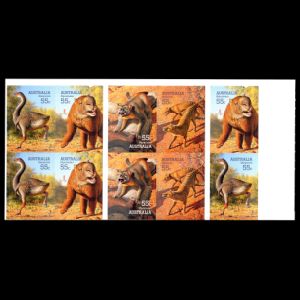 |
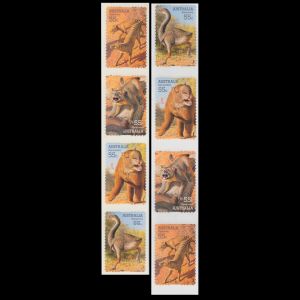 |
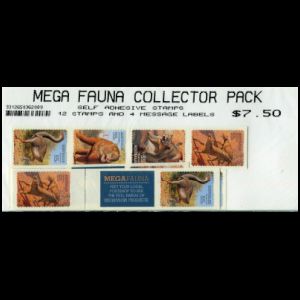 |
| The reverse side is here | The reverse sides are here | Some coil strips contained message labels between stamps |
| The self-adhesive coil stamps were printed by two companies: "Energi Print P/L" and "Pemara", which differ in the order and distance of the stamps in the coil and the company name on the reverse side. | ||
References:
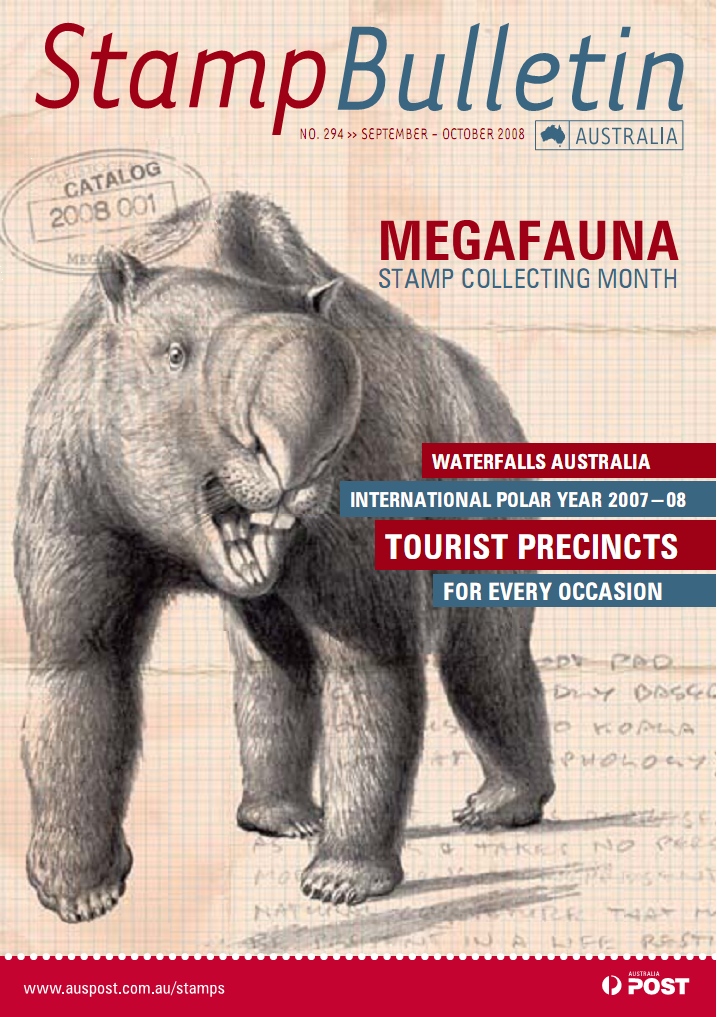 |

|
- Technical details: Stamp Bulletin of Australian Post, Nr. 294 from September-October 2008 (p. 14-17), reverse side of an official FDC, Prestige Booklet of Australian Post.
- Australian Megafauna: Wikipedia, Australian Geographic,
- Peter Trusler: Wikipedia, Monash University, Archive Monash University, Spiegel Wiessenschaft ,
- Professor Patricia Vickers-Rich: Wikipedia, Monash University,
- Genyornis: Wikipedia.
- Diprotodon : Wikipedia, Encyclopedia Britannica, Australian Museum,
- Thylacoleo: Wikipedia.
- Thylacinus: Wikipedia. Encyclopedia Britannica.
- Procoptodon : Wikipedia.
- Megalania: Wikipedia.
Acknowledgements:
Many thanks to Dr. Peter Voice from Department of Geological and Environmental Sciences, Western Michigan University, for his help to find an information for this article, the draft page review and his very valuable comments.
| <prev | back to index | next> |